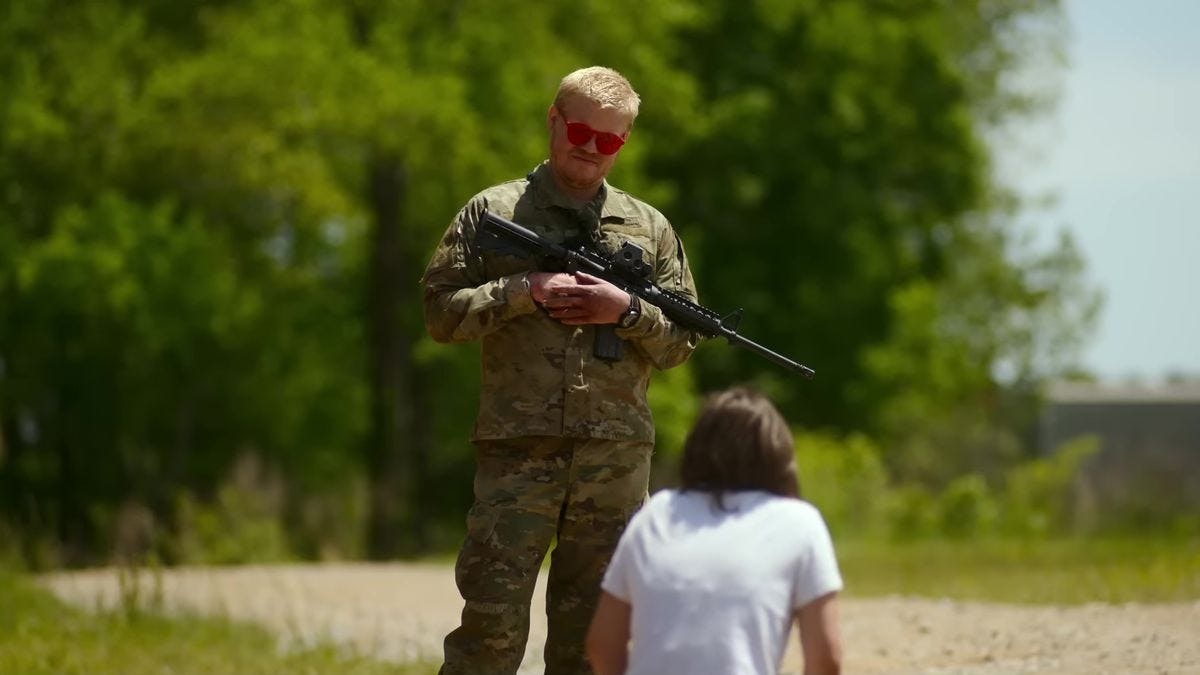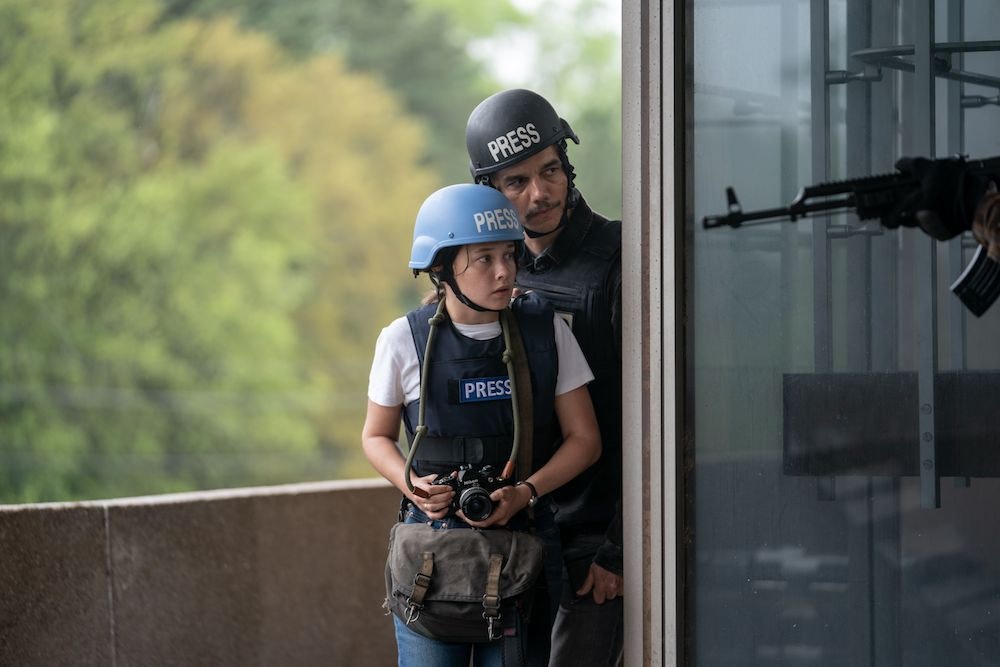
For a film its distributor describes as an “adrenaline-fueled thrill ride,” Alex Garland’s Civil War is surprisingly mellow and dialogue-driven for its first hour. Set in a war-torn America, the picaresque A24 road movie owes its stoicism to Kirsten Dunst’s weary photojournalist, Lee, who is numb to the horrors she witnesses en route to Washington, D.C. It’s the near future, and the retail apocalypse has brought crashed helicopters to the parking lot of your local JCPenney. Secessionists are also closing in on the nation’s capital as Lee and other members of the free press drive there to interview the three-term president before he’s deposed.
Armed gas station attendants, torture victims hanging in a car wash, militiamen executing hooded captives: these things don’t faze Lee. It’s not until an hour in, when Dunst’s real-life husband and Fargo costar, Jesse Plemons, makes an uncredited appearance, that Lee and her fellow journalists feel in true peril. This is where Civil War’s deliberately muddy politics fall away as it unearths prejudices beside a mass grave, confronting the characters and the audience with an overt threat that demands a non-neutral response. While it tests the limits of Lee’s unflappable field demeanor, the scariest scene in Civil War shows where the bodies are buried, both literally and figuratively.
Onscreen, we see the bodies in a hole in the ground, where a dump truck has unloaded them. Plemons’ blonde-haired soldier, dressed in camouflage and tinted red sunglasses, sprinkles them with lye. His hands are blood-caked, and his gun-toting compatriot seems ready to add the wide-eyed young photographer, Jessie (Cailee Spaeny), and her car-swapped driver, Bohai (Evan Lai), to the body pile. According to The Los Angeles Times, Civil War was shot chronologically, so the whole production had led up to this scene, with cinematographer Rob Hardy hiding in the mass grave to keep the actors immersed in the tension.
Lee’s Reuters colleague, Joel (Wagner Moura), strides in with her and the tag-along Tony (Nelson Lee) to defuse the situation, but he’s immediately put at a rhetorical disadvantage. Earlier in the movie, Lee says it’s a journalist’s job to “record, so people ask.” Plemons’ soldier is a frightening embodiment of that in that he never stops asking questions, loaded with live ammunition. As Joel attempts to talk him out of shooting anyone, the soldier does interject a few declarative statements and some terse utterances like, “Mm-hmm,” “Yeah,” and “Okay.” However, most of his lines are interrogative, with the oft-quoted “What kind of American are you?” forcing characters to identify their home region and take a side.
Spoiler alert: he starts shooting those who look foreign or not Midwestern enough. This hate crime cuts through the veneer of nonpartisanship and shows that Garland’s film isn’t entirely without political coding. “What’s in Charlottesville?” the soldier asks, and the viewer is left to fill in the real-world answer with their own knowledge of the Unite the Right rally in 2017. This is the same movie that opens with President Nick Offerman rehearsing a hyperbolic speech while dressed in a familiar red tie, white shirt, and blue suit.

Counting the first glimpse of him through Lee’s zoom lens, Plemons’ soldier is only in Civil War for about seven minutes. His glasses make him see the world in red, but prior to this scene, Lee and Jessie have seen it at a black-and-white remove, with their shutter clicks reducing it to still frames. In flashback images, it’s revealed that Lee has already photographed people getting shot and set on fire in other war zones abroad. At home in the U.S., societal collapse has become a mundane backdrop for inconveniences like slow Wi-Fi and power outages.
Lee and her colleagues sit around talking and sleeping through the sound of distant gunshots and explosions. On the road, they lurch from one episodic encounter to another, observing and reporting without participating. Though they briefly get caught in sniper crossfire, and Lee occasionally influences events by staging a photo op, she’s not really involved in the firefight until Plemons’ soldier begins picking off journos. In a sense, she’s no different from the small-town folk who “try to stay out” of the war, while her parents and Jessie’s sit on their farms and pretend it isn’t happening.
Civil War’s body pit scene is the put-up-or-shut-up moment where Lee and company can no longer afford to just be neutral observers. In terms of screenplay structure, it sets up the all-is-lost moment, which leads into the movie’s third act and an intense assault on the White House. There, too, we see that America’s divided forces are past the point of negotiating terms of surrender. To engage with the political powder keg is to risk sacrificing oneself on top of it. The only other option is to sit around and talk while the world is ending.







